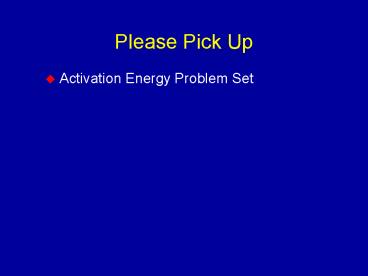Please Pick Up - PowerPoint PPT Presentation
1 / 32
Title:
Please Pick Up
Description:
Automobile catalytic converter. contains Pt, Pd, Rh, CuO and/or Cr2O3 ... dependence (kelvin) Rewrite the Arrhenius equation in straight line form. ... – PowerPoint PPT presentation
Number of Views:38
Avg rating:3.0/5.0
Title: Please Pick Up
1
Please Pick Up
- Activation Energy Problem Set
2
Mechanisms of Chemical ReactionsAgenda
- What is meant by a chemical mechanism.
- The relationship between the rate law and what is
occurring on the molecular level. - Identifying a possible mechanism.
- Catalytic reactions
- Chain reactions
3
Reaction Mechanisms
- Reading assignment
- Zumdahl Chapter 15.6
- The process by which the reactant becomes the
product is called the reaction mechanism. - Like a mechanical mechanism, the chemical
conversion process can take place in one step or
several steps. - The rate law (rate constant and order of the
reaction) is used to support or disprove various
possible reaction mechanisms.
4
Acid Catalyzed Conversion of Acetone to
1-propen-2-ol
H
A chemical mechanism is a number of steps which
occur sequentially to convert reactants into
products.
5
Acid Catalyzed Bromination of Acetone
Br-Br
6
Chemical Mechanisms
- A number of steps which occur sequentially to
convert reactants into products. - Usually one of the series of steps is slower than
the rest -- Rate Determining Step (RDS) - The rate law involves all the species involved in
the steps before the RDS.
7
Rate k H1 CH3COCH31 Br20
Which is the RDS?
8
Mechanism of Reaction
- A proposed molecular pathway or sequence of steps
in which the reactants are converted to products. - Must be consistent with all the known data.
- Can never be absolutely proven, only supported or
disproved. - A reaction may have multiple pathways, all
occurring at different rates at the same time.
9
Activation Energy
- Edward A. Mottel
- Department of Chemistry
- Rose-Hulman Institute of Technology
10
Activation Energy
- Reading assignment
- Zumdahl Chapter 15.8-15.9
- This lecture continues a discussion of the
factors that affect the rate of a chemical
reaction. - The topic of activation energy is introduced
along with the Arrhenius equation.
11
Reaction Rate
Factors that affect the rate of reaction
mechanism catalyst
12
Catalysts
- Change the rate of the chemical reaction
- Most catalysts increase the rate of reaction
- Types of catalysts
- Homogeneous
- Heterogeneous
- Automobile catalytic converter
- contains Pt, Pd, Rh, CuO and/or Cr2O3
- oxidizes CO and hydrocarbons to CO2 H2O
- reduces NOx (NO and NO2) to N2 and O2.
13
Catalysts
- The catalyst must
- take part in the reaction (and usually be in the
rate determining step - be regenerated so that it doesnt appear in the
overall balanced reaction.
14
Polymerization
Metal surface
15
Polymerization
Metal surface
16
Polymerization
Metal surface
17
Polymerization
Metal surface
18
Polymerization of Ethylene
C
M M M M M M M M M
CH3 - M
n H2C CH2
CH3 - H2C - CH2 n- M
polyethylene
ethylene monomer
Which steps of a chain reaction are shown?
19
Reaction Rate
Factors that affect the rate of reaction
mechanism catalyst
particle size
temperature
20
Reaction Coordinate DiagramCollision Theory
For a chemical reaction to occur, the
reactants must collide successfully with enough
energy to overcome the activation energy (Ea).
Ea
DH
If the products are more stable than
the reactants, DH lt 0, and the reaction is
exothermic.
21
Reaction Coordinate DiagramCatalyst
Why does the rate of reaction change when a
catalyst is added?
Why does DH for the reaction stay the same?
22
The Rate Constant
23
Arrhenius Equation Factors Affecting the Rate of
Reaction
The Arrhenius equation allows the rate of a
reaction to be calculated at different
temperatures.
Rewrite the Arrhenius equation in straight line
form.
24
Arrhenius EquationLinear Form
-Ea/R
ln (Rate Constant)
Inverse Temperature (K-1)
25
(No Transcript)
26
Arrhenius Equation
The rate constant for a chemical reaction is 4.0
x 10-4 s-1 at 280. K and 1.6 x 10-3 s-1 at 300. K.
What is the activation energy of this reaction?
What rate constant would be expected at 320. K?
27
Boltzmann Distribution
The rate of many organic chemical reactions
double with every 10 degree change in temperature.
28
Reaction Rates vary with Temperature
The rate of many organic chemical
reactions doubles with every 10 degree Celcius
change in temperature around room temperature.
If you run a fever of a 103 F (39.4 C), how
much faster is your body running, than at a
normal temperature?
29
Chain Reactions
- A chain reaction occurs when a reactive species
forms a product and another reactive species. - Branching chain reactions produce the product and
multiple reactive species. - A reaction which releases heat and generates an
increasing number of reactant species can be
explosive.
30
Mechanism for Reaction ofHydrogen and Oxygen
spark
HH
Initiation Step
H H
Propagation Steps
Termination Steps
Chain reactions have three different kinds of step
31
Mechanism for Reaction ofHydrogen and Oxygen
H2O
H
HO
H2
Propagation Steps
H O2
O
H2
HO
H
H2
After each cycle, three H are formed for each
one used.
H2O
H
32
Mechanism for Reaction ofHydrogen and Oxygen
H2
H H
H2O
HO H
HO
O H
Termination Steps
33
(No Transcript)














![❤[READ]❤️ How to Pick Pockets PowerPoint PPT Presentation](https://s3.amazonaws.com/images.powershow.com/10083310.th0.jpg?_=20240722056)
















